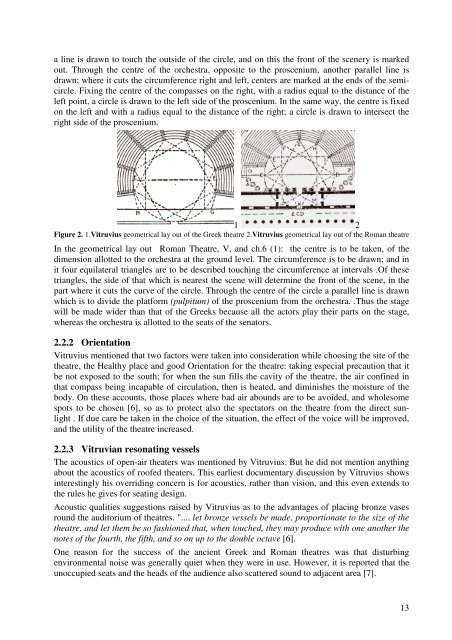ERATO Proceedings Istanbul 2006.pdf - Odeon
ERATO Proceedings Istanbul 2006.pdf - Odeon
ERATO Proceedings Istanbul 2006.pdf - Odeon
Create successful ePaper yourself
Turn your PDF publications into a flip-book with our unique Google optimized e-Paper software.
a line is drawn to touch the outside of the circle, and on this the front of the scenery is marked<br />
out. Through the centre of the orchestra, opposite to the proscenium, another parallel line is<br />
drawn; where it cuts the circumference right and left, centers are marked at the ends of the semicircle.<br />
Fixing the centre of the compasses on the right, with a radius equal to the distance of the<br />
left point, a circle is drawn to the left side of the proscenium. In the same way, the centre is fixed<br />
on the left and with a radius equal to the distance of the right; a circle is drawn to intersect the<br />
right side of the proscenium.<br />
1 2<br />
Figure 2. 1.Vitruvius geometrical lay out of the Greek theatre 2.Vitruvius geometrical lay out of the Roman theatre<br />
In the geometrical lay out Roman Theatre, V, and ch.6 (1): the centre is to be taken, of the<br />
dimension allotted to the orchestra at the ground level. The circumference is to be drawn; and in<br />
it four equilateral triangles are to be described touching the circumference at intervals .Of these<br />
triangles, the side of that which is nearest the scene will determine the front of the scene, in the<br />
part where it cuts the curve of the circle. Through the centre of the circle a parallel line is drawn<br />
which is to divide the platform (pulpitum) of the proscenium from the orchestra. .Thus the stage<br />
will be made wider than that of the Greeks because all the actors play their parts on the stage,<br />
whereas the orchestra is allotted to the seats of the senators.<br />
2.2.2 Orientation<br />
Vitruvius mentioned that two factors were taken into consideration while choosing the site of the<br />
theatre, the Healthy place and good Orientation for the theatre: taking especial precaution that it<br />
be not exposed to the south; for when the sun fills the cavity of the theatre, the air confined in<br />
that compass being incapable of circulation, then is heated, and diminishes the moisture of the<br />
body. On these accounts, those places where bad air abounds are to be avoided, and wholesome<br />
spots to be chosen [6], so as to protect also the spectators on the theatre from the direct sunlight<br />
. If due care be taken in the choice of the situation, the effect of the voice will be improved,<br />
and the utility of the theatre increased.<br />
2.2.3 Vitruvian resonating vessels<br />
The acoustics of open-air theaters was mentioned by Vitruvius. But he did not mention anything<br />
about the acoustics of roofed theaters. This earliest documentary discussion by Vitruvius shows<br />
interestingly his overriding concern is for acoustics, rather than vision, and this even extends to<br />
the rules he gives for seating design.<br />
Acoustic qualities suggestions raised by Vitruvius as to the advantages of placing bronze vases<br />
round the auditorium of theatres. ".... let bronze vessels be made, proportionate to the size of the<br />
theatre, and let them be so fashioned that, when touched, they may produce with one another the<br />
notes of the fourth, the fifth, and so on up to the double octave [6].<br />
One reason for the success of the ancient Greek and Roman theatres was that disturbing<br />
environmental noise was generally quiet when they were in use. However, it is reported that the<br />
unoccupied seats and the heads of the audience also scattered sound to adjacent area [7].<br />
13
















